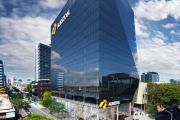
Back in the black: YHA sees bright future for hostels
YHA Australia, the 80-year-old hostel operator, had its first profitable months of trading in April and May after a horror two-year period where it had to sell assets, refinance its debt and slash its workforce to survive.
“We’re back in the black and our forward [bookings] business is looking relatively strong,” said YHA chief executive Paul McGrath, who took over the running of the company in April 2020. This was just as Australia was shutting its international border to combat the first wave of the pandemic, starving the organisation of its biggest customer base: overseas backpackers.
“The timing of my arrival [as CEO] one month into the pandemic was not ideal,” Mr McGrath told The Australian Financial Review.
But as international travellers return, and having used the pandemic as a springboard to restructure the business, Mr McGrath expects occupancy rates of about 50 per cent this year across its network of 49 properties, followed by a return to pre-pandemic occupancy rates of 65 per cent and higher in 2023 and 2024.
It is a far cry from most of 2020 and all of last year when occupancy rates plunged to as low as 10 per cent, more than halving the non-profit organisation’s annual revenue (from $46.2 million in 2019 to less than $19 million last year) and generating trading deficits of more than $10 million in each of the past two years.
Its shrinking revenues pushed YHA into “survival mode” as it began selling properties to ensure it had sufficient cash flow and as its bank lenders demanded that it pay down its debt.
“From a business point of view, the pandemic was devastating. But it was also the catalyst to make the significant changes that we needed to,” Mr McGrath said.
Mr McGrath said the organisation had to take a hard look at its portfolio and decide which properties it wanted to hold on to and those it needed to let go.
This led to the sale of about $40 million of assets including hostels in Sydney, Perth, Airlie Beach and Canberra, and land it owned on the Gold Coast.
It has left YHA with a portfolio of 24 owner-operated hotels valued at $206 million alongside 25 operated by associates under a franchise-style agreement.
Needing “room to breathe” and a more accommodating lender partner, YHA Australia was able to refinance about $100 million of bank debt after turning to Melbourne-based investment and advisory firm Planum Partners. Planum secured a syndicate of non-bank lenders that includes Aware Super and a global real estate investor.
The deal meant YHA did not have to sell any more assets and had enough working capital for the next three to four years so that it could focus on preparing the business for life after the pandemic.
Part of this preparation for the reopening of borders was evolving the business to cater for the needs of its broadening customer base, and to remain competitive against new cashed-up entrants to the budget accommodation sector such as Selina and Drifter Hospitality.
The transformation program initiated by Mr McGrath included the more obvious things such as renovating its key capital city properties and overhauling its technology platform. But it also meant embracing new ideas such as co-working and providing a better selection of food and beverage options.
The first of these co-working hubs will open at its YHA Blue Mountains property in the coming weeks, and another at its Byron Bay hostel will open in the next few months.
“Our research found there is great demand for these facilities, both from locals and from our guests, about 10 per cent of whom are working nomads,” Mr McGrath said.
Co-working will also be a feature of a new YHA “hostel of the future” which will open in 2026 in the new Atlassian hybrid timber building at Sydney’s Tech Central Precinct.
“We’re really just two months into making money again,” he said.
Sustainability is also a key part of its transformation. YHA generates 14 kg of CO2 per guest per night, which Mr McGrath said was “very low” given caravan parks generate three times that amount.
“We think we can be carbon-neutral by 2024 or 2025. With the right investments, we could even be carbon positive.”










